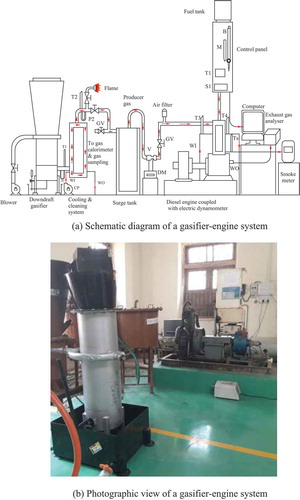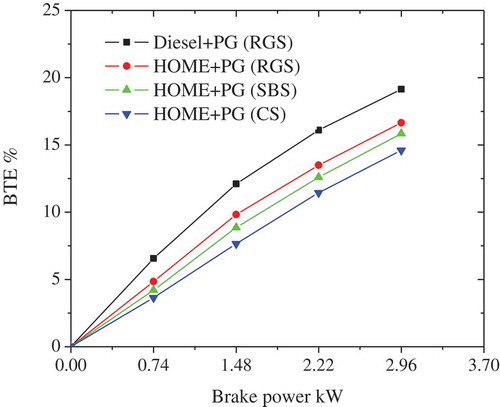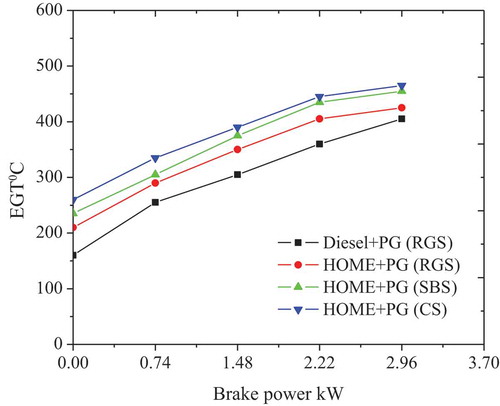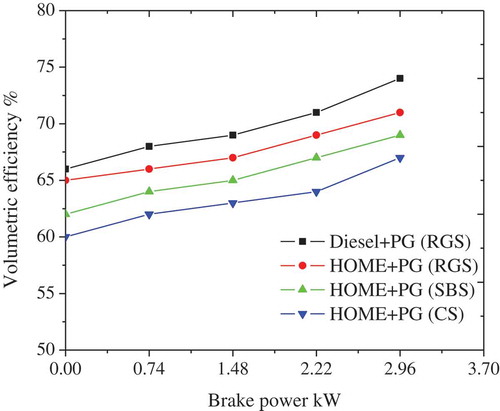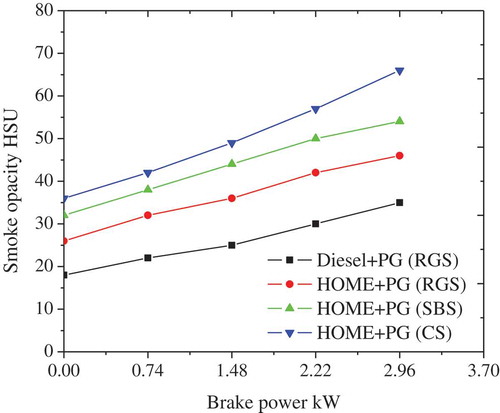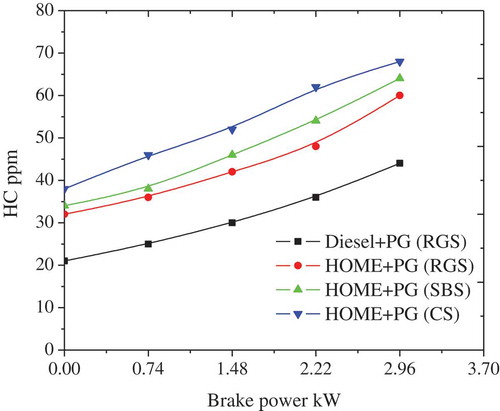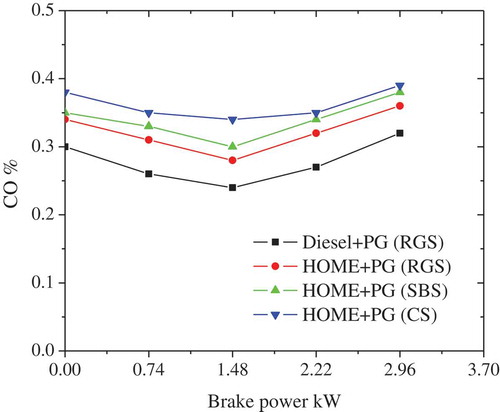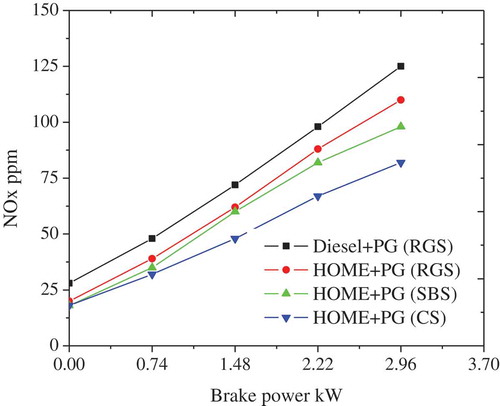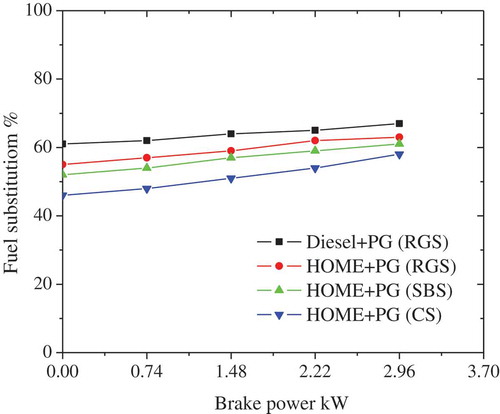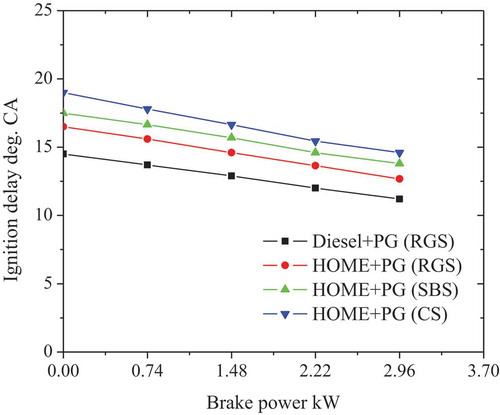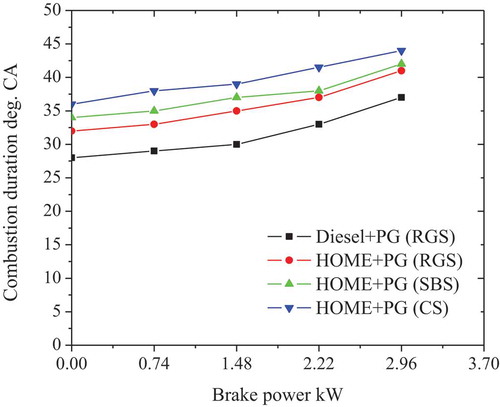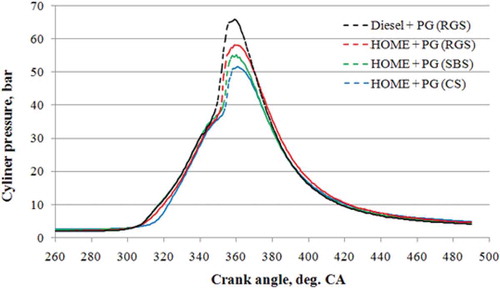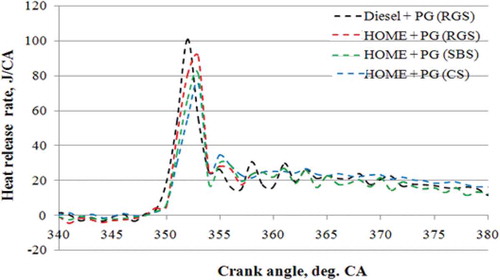ABSTRACT
In this present work, performance and emission levels have been investigated using renewable and sustainable fuels derived from different agricultural residues. For the same injected pilot fuel, producer gas operation with redgram stalk (RGS) derived fuel provided improved liquid fuel saving. Downdraft gasifier was integrated with 4 stroke direct injection water cooled 5.2 kW CI engine at 1500 rpm and run under dual fuel mode using diesel/honge oil methyl ester (HOME)-producer gas. Experimental investigation showed that the gasifier-engine system with diesel-RGS derived producer gas dual fuel operation results in 13.05% higher brake thermal efficiency. Diesel-producer gas (RGS) operation showed the 16.1% decreased exhaust gas temperature and the 12.1% higher nitric oxide (NOx) emission compared to HOME based dual fuel operation. NOx emissions for the HOME based engine operation were found to be lower than the diesel based operation; however, the smoke, hydrocarbon, and carbon monoxide emissions were higher. Diesel fuel saving about 56% was achieved by diesel-producer gas (RGS) dual fuel operation and 100% biofuel utilization in HOME-producer gas dual fuel operation. Further, cylinder pressure and heat release rates for HOME-producer gas (RGS) were marginally lesser than the diesel based operation
1. Introduction
The emission levels generated from the burning of agricultural wastes in the field is alarming and adds to greenhouse gas emissions. Hence the utilization of this agricultural biomass for power production should be given importance in the renewable energy scenario for the developing countries like India. The enormous quantity of agricultural waste residue is generated in India about 686 MT per year of which 34% was approximated as surplus for bioenergy production (Kumar et al. Citation2015). Agricultural residue includes various residues and the agricultural remainder which corresponds to the potential energy of about 18,000 MW and power generation installed capacity from biomass is 2559 MW. India has the potential to produce about supplementary 20 GW of power from agricultural residues (Awasthi and Karishma Citation2013; Murugesan et al. Citation2009). Increasing utilization and cost of conventional fuels due to its depleting nature and several other issues leads to concentrate on economic, environment-friendly and energy efficient resources. The agricultural residue is one of the renewable and environmentally friendly energy sources and it can be used to generate producer gas from the suitable gasifier, which can in turn coupled to CI engine system for generating electricity.
Biomass contributes to global energy consumption at about one-seventh and has an enormous potential to be used as an alternative and renewable resource which can be restored. India has a greater waste terrain of about 107 million hectares of disgraced and 64 million hectares of the wasteland for biomass generation, which is presently underutilized. Biomass is available from different resources like forest waste (twigs, leaves, and wood), agricultural waste (crop stalks and husks) and industrial waste (wood chips, carpentry waste, and sawdust). India generates about 400–500 million tonnes of agricultural residues every year. In this view, biomass-based electricity generation can be used conveniently. To generate energy from waste biomass, the government of India has facilitated several national level programs (Banapurmath et al. Citation2018). Energy generation from biomass gasification is found to be a better option in the remote and rural areas where the supply of power from grid not possible.
Several investigators have reported the use of biomass for energy generation is the important requirement to become self-reliant in the energy sector (Parikh, Bhave, and Kapse Citation1989; Vyarawalla et al. Citation1984; Sridher, Paul, and Mukunda Citation2001; Lal and Mohapatra Citation2017; Singh, Singh, and Pathak Citation2007; Banapurmath and Tewari Citation2008; Sahoo, Sahoo, and Saha Citation2009). The SI engine can be run on 100% PG and CI engine can be operated in dual fuel mode using pilot fuels as injected fuel. PG alone cannot ignite in CI engine because of its high auto-ignition temperature, therefore, to imitate the combustion in CI engine; a little quantity of liquid fuel must be used. Use of low calorific value PG in the CI engine lowers thermal efficiency, NOx and smoke levels, however, increases the HC and CO emissions because of incomplete burning of gaseous fuel at low load operation due to the lower combustion temperature during engine operation under dual fuel mode (Yaliwal et al. Citation2014; Dhole, Lata, and Yarasu Citation2016). Some researchers reported that dual fuel operation results in saving of pilot fuel about 60–80% (Karabektas, Ergen, and Hosoz Citation2014; Liu et al. Citation2013; Yaliwal et al. Citation2016; Sombatwong, Thaiyasuit, and Pianthong Citation2013). Authors reported that dual fuel operation using alternative fuels such as biodiesels and PG from different resources have numerous benefits like socio-economic balance. Use of biofuels can also address the energy security and environmental issues in the most appropriate direction (Banapurmath and Tewari Citation2009; Yoon and Lee Citation2011). In addition, the diesel engine is used for dual fuel operation with suitable modifications (Lal and Mohapatra Citation2017). Many researchers put an effort to enhance the diesel-PG fueled engine performance varying operating parameters of the engine as well as a gasifier. Dual fuel operation favors the use of higher compression ratio, hydrogen addition, change of injection strategies and advanced injection timing (Lal and Mohapatra Citation2017; Sahoo, Sahoo, and Saha Citation2009; Yaliwal et al. Citation2014). Use of hydrogen-enriched PG during dual fuel operation (or tri-fuel operation) resulted in increased performance with lower emission levels (Dhole, Lata, and Yarasu Citation2016; Karabektas, Ergen, and Hosoz Citation2014; Liu et al. Citation2013; Yaliwal et al. Citation2016; Sombatwong, Thaiyasuit, and Pianthong Citation2013). The addition of hydrogen in PG results in better fuel mixture combustion at higher load conditions (Dhole, Lata, and Yarasu Citation2016). Reduced NOx emission levels and increased HC and CO levels resulted in with hydrogen addition (Banapurmath et al. Citation2011; Malik and Mohapatra Citation2013).
Few researchers have studied the combustion characteristics of a diesel/biodiesel-PG fuelled dual fuel engine using biomass feedstocks from different origin (Liu et al. Citation2012). Study of various crop stalks for bioenergy production was carried out (Xinyan et al. Citation2018). Pyrolysis of various agricultural residues such as wheat and rice straw, rape and cotton stalk was studied under different temperatures (Shashikantha and Parikh Citation1999). It has been observed that decreased biochar and increased gas yield from temperature 300°C to 600°C and CO2, CO were reduced with temperature. Commonly used biomass for the gasifier-engine system includes coconut shell, acacia wood, crop residues, coir pith, sesame wood, honge, and babul wood. Use of biomass for power generation using the gasifier engine system and effects on the combustion characteristics of the engine under dual fuel have been reported (Parikh, Bhave, and Kapse Citation1989; Lal and Mohapatra Citation2017; Singh, Singh, and Pathak Citation2007; Yaliwal et al. Citation2014; Uma et al. Citation2004; Vyas and Singh Citation2007; Sheth Pratik and Babu Citation2009; Asadullah Citation2014). Higher calorific value and density of biomass feedstock are more suitable for PG generation as these biomass results into quality PG generation and maximum saving of pilot fuel can be achieved with acceptable engine performance and emission levels.
Use of loose biomass in the form of briquettes instead of wood chips lowers the clogging of biomass at the throat (Akkoli et al. Citation2018). The barriers for use of PG for dual fuel mode engine operation are clogging of biomass resulting in a lower rate of gas production and tar formation at higher temperature leading to chocking of gas and poor performance (Shelke and Mahanta Citation2016). The tar formation depends upon the type of gasifier and biomass feedstock used. This can be reduced using an appropriate cooling and cleaning system (Yaliwal, Banapurmath, and Tewari Citation2013). However, to use this combustible gas in a diesel engine under dual fuel mode, the suitable engine design changes and minor engine modifications are necessary. Greater the hydrogen to carbon ratio leads to increased gasification efficiency and generates a combustible gas with low tar. However, the presence of high cellulose content in biomass leads to rapid burning of biomass and hemicelluloses retards the combustion inside the gasifier. Thus both cellulose and hemicelluloses content in the biomass must be in a balanced state (Yaliwal, Banapurmath, and Tewari Citation2013).
2. Materials and methods
In this present work, three agricultural residues (biomass) such as redgram stalk, soyabean stalk, and chilli stalk were selected as the gasifier feedstocks because these are available abundantly at the local region and suitable for PG generation by downdraft gasifier. Further, the study of the effect of PG derived from agricultural residues RGS, SBS and CS on the performance and emission characteristics was carried out. Also, the effect of biomass components such as lignin, cellulose and hemicellulose content with all other properties were investigated. The results obtained with HOME based dual fuel operation were compared and analyzed with diesel based dual fuel operation.
2.1 Characterization of fuels used
Properties of biomass affect the combustion and exhaust emissions of a PG fuelled dual fuel engine. Therefore, biomass characterization was studied for the proficient operation of the engine. The proximate and ultimate analysis gives valuable information regarding combustion characteristics of the biomass. These characteristics of biomass explain their potential candidature for the PG generation. Various properties of pilot fuels and agricultural residues used are listed in and lignocellulosic properties are in .
Table 1. Properties of pilot fuels and biomass.
Table 2. HHV prediction using the correlations.
Table 3. Lignocellulosic properties of biomass.
The correlations used above reveals that the ultimate analysis results are more suitable for determining the HHV of biomass. Eqs. (1) and (2) using the results of proximate analysis estimates HHV poorly. The Eq. (3) is the better correlation based on the proximate analysis. The Eqs. (4) to (6) gives the HHV very close to each other using the results of ultimate analysis shown in . This comparison also shows that the three elements carbon, hydrogen and oxygen are the key parameters in the correlations to get less error in the estimation of HHV.
‘The values in parenthesis are standard deviation at a 95% confidence interval. Number of determination is 3’ (33)
3. Experimental setup
Experimentation was carried out using a downdraft gasifier-engine system as shown by schematic and photographic views in .
The Energy and Resources Institute (TERI) design downdraft gasifier with 10 kg/hour biomass consumption and 40 kg hopper capacity with the closed top was used. The throat less gasifier with a forced air supply at the reaction zone provides the convenience and reduces the biomass chocking. The CI engine was coupled with the downdraft gasifier. Engine and downdraft gasifier specifications are presented in . The engine has a fuel injection nozzle having 3 holes (nozzle size is 0.3 mm and spray angle of 120°) and HCC. Agricultural residues (RGS, SBS, and CS) were fed to the downdraft gasifier for the PG generation. Pilot fuel and PG flow rates were maintained during the experiment and both were measured using calibrated burette with a stopwatch (volumetric basis) and digital flowmeter respectively. As per the engine manufacturer, the static injection timing, injector opening pressure, and CR were 23° bTDC, 205 bar and 17.5 respectively. However, for both diesel and HOME based dual fuel operation, injection timing, injection pressure were changed to 27° bTDC, 230 bar. The speed of the engine is maintained at 1500 rpm and the load was varied from the 0 to 80%.
Table 4. Specifications of CI engine and downdraft gasifier.
4. Results and discussion
For HOME-PG dual fuel engine operation, all the three biomass feedstocks RGS, SBS, and CS were used and results were compared with diesel-PG (RGS) operation.
4.1 Performance
4.1.1 Brake thermal efficiency
For the same injected fuel, the BTE of PG fuelled dual fuel engine significantly depends on the biomass feedstock type which decides primarily the quality of PG generated. In this regard use of PG from different agricultural residue feedstocks in a dual fuel engine operation provided the varying brake thermal efficiency as shown in . BTE of the diesel-PG operation was always higher than HOME-PG operation for a given load range. RGS derived PG-diesel; CI engine operation resulted in 13.05% higher BTE when compared to HOME based operation at 80% load.
Lower thermal efficiency for the HOME based engine operation is because of reduced air/fuel equivalence ratio, and the shared effect of the energy content of HOME and PG, a low volatile characteristic and higher density with higher viscosity of HOME. However, longer ignition delay of biodiesel in presence of sluggish burning PG is also accountable for the trend. In addition, enhanced work during compression, decreased turbulent flame propagation, lower flame temperature and speed of the PG leads to reduced BTE of HOME based dual fuel engine (Yaliwal et al. Citation2014).
Higher BTE of dual fuel engine operation was recorded for HOME–PG derived from RGS compared to the operation with HOME-PG derived from SBS and CS. The thermal efficiencies for the dual fuel engine operation with HOME–PG derived from the RGS, SBS, and CS were found to be 16.65%, 15.85%, and 14.82% compared to 19.15% for diesel–PG (RGS) operation at 80% load.
4.1.2 Exhaust gas temperature
Exhaust gas temperature depends on the combustion behavior and how much energy was consumed during the premixed combustion phase. In addition, the quality of combustible gas can also bring out variations in the EGT. presents the EGT variation with respect to brake power for various fuel combinations used. From the figure, it follows that HOME–PG dual fuel operation provides 16.1% higher EGT than diesel-PG operation. It is due to reduced mixing rates and burning rate of fuel combination during the premixed combustion phase which in turn leads to the partial combustion of the HOME–PG. The obtained results were in close accord to the published literature (Lal and Mohapatra Citation2017; Yaliwal et al. Citation2014).
However, for the same HOME-PG (RGS) dual fuel operation provides comparatively lower EGT than the operation with SBS and CS derived PG operation. Inferior quality of PG caused by ash and lower energy content of PG leads to partial combustion. However, the maximum lignin content in the biomass feedstock of SBS and CS may also be accountable for the trend observed. The EGT values for the dual fuel engine operated on HOME–PG derived from the RGS, SBS, and CS were found to be 425 °C, 455 °C, and 462 °C compared to 405 °C for diesel–PG (RGS) operation for 80% load.
4.1.3 Volumetric efficiency
Volumetric efficiency for different fuel combinations with respect to brake power is presented in . The breathing ability of an engine can be determined by volumetric efficiency. The lower volumetric efficiency has been noticed for all the fuel combinations because of the deficiency of the oxygen during dual fuel operation. Further, dual fuel operation causes increased gas temperature due to increased valve temperature which in turn leads to reduced air density. Because of this reason, lower volumetric efficiency observed with PG fuelled dual fuel engine operation and also during fuel induction, part of PG was substituted in place of air reason for lower volumetric efficiency. However, it is observed that for the same HOME-PG (RGS) operation provides 5.6% higher volumetric efficiency compared with SBS and CS-based operation at 80% load. The lower quality of PG during the operation with SBS and CS derived fuels may be the reason. But diesel-based operation gives improved volumetric efficiency compared to HOME based operation. The volumetric efficiency values for the dual fuel engine operation with HOME–PG derived from the RGS, SBS, and CS were found to be 71.2%, 69.1%and 67.2% compared to 74.5% for diesel–PG operation for 80% load.
4.2 Emission characteristics
Emission levels depend on the combustion behavior of fuel in the engine cylinder. The combustion behavior depends on the type of fuel, engine design, and operating parameters. Emissions of the PG fuelled diesel engine was recorded when the engine works under steady state conditions. Various emissions of the dual fuel engine are summarized in the following subsequent sections.
4.2.1 Smoke opacity
Variations in the smoke opacity for selected fuel combinations with respect to brake power were presented in . Lower smoke levels were observed for diesel–PG dual fuel engine operation compared with the HOME–PG operation over the given load range. For the RGS derived PG induction, diesel-based dual fuel operation provides 23.6% reduced smoke levels compared to HOME based operation at 80% load. This is due to differences in the molecular structure of the injected pilot fuels. For the same inducted fuel, HOME based dual fuel operation leads to partial combustion due to differences in the spray pattern. Lower air/fuel equivalence ratio, inappropriate air-fuel mixing due to inefficient utilization of air for the HOME–PG combination is also accountable for higher smoke levels. However, lower smoke levels were observed for HOME based dual fuel engine operation with PG derived from RGS compared to the operation with SBS and CS derived PG. This could be attributed to reduced oxidation (partial combustion) due to the presence of more ash and higher moisture content in SBS and CS leading to retard the combustion of fuel combinations. Higher ash in the SBS and CS may retard the oxygen utilization during combustion. In addition, the more lignin presence in both SBS and CS may also be responsible for the observed trends. RGS biomass has comparatively higher density, cellulose, and hemicellulose leading to burning efficiently which in turn lowers the smoke. The smoke levels for the HOME-PG dual fuel operation with RGS, SBS, and CS derived PG were found to be 46 HSU, 54 HSU, and 66 HSU compared to 35 HSU for the diesel–PG operation at 80 % load.
4.2.2 HC and CO emissions
and provide the variations in HC and CO emissions with respect to brake power for various fuel combinations. Both HC and CO levels in the exhaust indicate incomplete combustion of fuel combinations. Results showed that lower HC and CO levels in the exhaust for the diesel–PG (RGS) operation compared with the HOME–PG operation for the entire load range. For the same RGS derived PG induction, diesel-based dual fuel operation provides 24.5% lower HC and 15.8% lower CO levels compared to HOME based operation at 80% load. HOME based dual fuel operation resulted in higher HC and CO emission levels compared to diesel-based operation due to differences in the spray characteristics caused by the differences in the fuel properties. Further, it is noticed that for the same pilot fuel, engine operation with PG derived from RGS provides lower HC and CO levels compared to the operation with SBS and CS derived PG. In addition, reduced oxygen due to the replacement of air during engine operation with SBS and CS affects the combustion negatively.
The HC emission in the exhaust for the dual fuel engine operation with HOME–PG derived from the RGS, SBS, and CS was found to be 60 ppm, 64 ppm, and 68 ppm, compared to 36 ppm for diesel–PG operation at 80% load. Similarly, the CO values for the dual fuel engine operated on HOME–PG derived from the RGS, SBS, and CS were found to be 0.32%, 0.35%, and 0.36% compared to 0.27% for diesel–PG operation at 80% load.
4.2.3 NOx emission
demonstrates the variations in NOx emission levels with respect to brake power and various fuel combinations. For the same inducted fuel, higher NOx levels were observed for diesel based dual fuel operation compared to HOME based operation over the entire load range. HOME based RGS derived PG induction has 12.1% lower NOx level compared to diesel based dual fuel operation at 80% load. This is mainly caused by the better-premixed combustion which in turn leads to increased heat release for the diesel based operation. Further, HOME based operation provides lower NOx levels due to the lower energy content of both HOME and PG, poor spray characteristics, the lower flame temperature of PG and lower air/fuel equivalence ratio over the entire load range. In addition, deficiency of oxygen during combustion and greater molecular structure of HOME are also accountable for this trend. HOME-PG derived from RGS operation provides marginally increased NOx compared to that operation with PG derived from the SBS and CS respectively. This is caused by the occurrence of higher cellulose and hemicellulose and lesser lignin content in the RGS compared to SBS and CS. However, RGS has good calorific value, density and desired moisture content leads to better quality PG. The occurrence of moisture in a HOME affects the combustion positively which in turn increases the NOx levels. The NOx values in the exhaust for the engine operated on HOME–PG derived from the RGS, SBS, and CS were found to be 110 ppm, 96 ppm, and 82 ppm compared to 125 ppm for diesel–PG (RGS) operation at 80% load.
4.3 Fuel substitution
illustrates the fuel substitution with respect to various brake power and fuel combinations. For the same inducted fuel, higher fuel substitution was noticed for diesel based dual fuel operation compared to HOME based operation over the given load range. Pilot fuel properties significantly affect the fuel substitution and quality of PG as well. For HOME-PG operation, fuel substitution was marginally higher when the operation was with PG derived from RGS compared to SBS and CS for the entire load range. This could be caused by the lower energy content, density and the comparatively greater moisture, ash present in the SBS and CS feedstocks. The fuel substitution values with HOME–PG derived from the RGS, SBS, and CS were 50%, 46%, and 42% compared to 56% for the diesel–PG operation.
4.4 Combustion analysis
Combustion characteristics of the engine operation mainly depend on the fuel properties, the amount of fuel consumed, engine design and operating parameters. Further, combustion in a dual fuel engine differs when producer gas used. Various combustion characteristics determined for dual fuel engine operation are summarized in the following sections.
4.4.1 Ignition delay
demonstrates the variations of ignition delay with respect to brake power for various fuel combinations. For all fuel combinations tested, the ignition delay was decreased with the increase in load. This could be because of the higher combustion temperature and lowered mixture strength at higher loads. It was noticed that for the RGS derived PG, delay period for HOME based dual fuel operation was 11.68% higher compared to diesel-based operation. This is caused by the higher autoignition temperature of PG. For the same injected fuel, dual fuel operation with RGS derived PG, the ignition delay period was found to be marginally lower compared to the operation with SBS and CS derived PG at all loads. This beng caused by the higher energy content of RGS biomass and adequately good quality of the PG. The values of the ignition delay were found to be 12.68 deg. CA, 13.8 deg. CA and 14.6 deg. CA for the HOME–PG RGS, SBS, and CS operations compared with 11.12 deg. CA for the diesel–PG (RGS) operation for 80%load.
4.4.2 Combustion duration
HOME based dual fuel operation results in increased combustion duration compared to diesel-based operation. It was noticed that for the RGS derived inducted fuel, combustion duration for HOME based dual fuel operation was found to be 9.8% higher than the diesel based operation. This is due to the increased ignition delay caused by the inappropriate spray characteristics due to the higher viscosity of HOME. Further, the presence of slow burning and low calorific value PG in the engine cylinder requires more time for combustion, which in turn increases the combustion duration. It is observed that HOME based dual fuel operation with RGS derived PG provides slightly lower combustion duration than the operation with SBS and CS derived fuel. The combustion duration values were found to be 39.4 deg. CA, 42.5 deg. CA and 44.2 deg. CA for the HOME–PG derived from RGS, SBS and CS operations compared to diesel–PG (RGS) operation 36.01 deg. CA at 80% load. From , it is noticed that the increase in load increases the combustion duration due to the fact that more quantity of fuel burns at higher loads.
4.4.3 Cylinder pressure
presents the variation of cylinder pressure with respect to different crank angle positions for various fuel combinations at 80% load. It was noticed that for the same RGS derived inducted fuel, cylinder pressure for diesel based dual fuel operation was found to be 16.1% higher compared to HOME based operation. Dual fuel operation with diesel as pilot fuel, the combustion was completed within a short time due to the higher flame speed of pilot fuel; this, in turn, burns the PG along with pilot fuel leading to higher cylinder pressures. It is obvious from , during HOME based dual fuel operation most of the fuel combination burns in the diffusion combustion phase rather than rapid combustion phase resulting in lower cylinder pressure. This is due to lower combustion rate caused by the poor spray characteristics of HOME. This further leads to slow down the burning of gaseous fuel. It is well known that the cylinder pressure significantly relies on the rate of combustion, quality, and quantity of fuel utilization during rapid combustion phase. This is mainly ruled out by mixture strength and ignition delay period. From it is noticed that for the same HOME biodiesel injected fuel, the cylinder pressure for RGS derived PG operation provides 6.1% and 11.5% higher cylinder pressure compared to the SBS, and CS derived PG operation respectively at 80% load. Longer delay period due to poor spray pattern of HOME and inferior quality of PG due to the presence of comparatively higher lignin content in the SBS and CS is responsible for the observed trends. The occurrence of greater lignin in a biomass feedstock results in slower burning rates. Poor-quality of the PG may lead to lower air entrainment and air-fuel mixing rates.
4.4.4 Heat release rate
illustrates the heat release rate with respect to the crank angle for the different fuel combinations for the 80% load. Investigation showed that HOME–PG derived from the RGS, SBS, and CS operation provides a decreased heat release rate compared to diesel-based operation. The lower energy content, low volatile matter, density, and greater ash and the presence of lignin in the biomass feedstock are accountable for the decreased heat release rate. Investigation showed that for the same HOME biodiesel operation, RGS derived PG resulted in a marginal increase in the heat release rate due to the better burning of fuel combination caused by the presence of cellulose and hemicellulose in the RGS biomass feedstock. Further, it is evident from that, the peak energy release curve is shifted 5–8° towards the right for HOME and PG operation. Because of this, fuel combination requires comparatively more combustion time or longer ignition delay. Lower heat release rates (HRR) of HOME and inferior quality of PG caused by the presence of comparatively higher lignin content in the biomass of SBS and CS are responsible for the observed trends. The occurrence of greater lignin in a biomass feedstock results in slower burning rates. Poor quality of the PG may lead to lower air entrainment and air-fuel mixing rates and hence lower values of HRR.
5. Estimation of error
All experimental data were associated with errors that ultimately limited the conclusions of this study. Random errors result from fluctuations that may result from several tests of a given measurement. Systematic errors can be corrected by periodic calibration of instruments. Errors of different quantities were estimated and found to be respectively 1.45, 14.46, 3.2, 6.72, 4.36, 13.21 and 3.34% for BTE, EGT, volumetric efficiency, smoke opacity, CO, NOx, and fuel substitution.
6. Conclusions
From the experiments conducted with the use of agricultural residues derived PG in the dual fuel CI engine operations with the diesel/HOME as injected pilot fuel, the following conclusions were drawn.
Brake thermal efficiency of CI engine is higher with diesel/HOME-RGS derived PG dual fuel operation compared to SBS and CS derived PG operation.
Diesel-RGS derived PG dual fuel operation provides 13.05% increased thermal efficiency and 16.1% decreased EGT compared to HOME based operation.
RGS derived PG induction, diesel-based dual fuel operation provides 23.6% reduced smoke 24.5%, and 15.8% lower, HC and CO emission levels compared to HOME based operation. Further, the 12.1% higher NOx compared to HOME based operation.
Fuel substitution about 56% for the diesel–PG (RGS) operation and for HOME–PG derived from the RGS, SBS, and CS were 50%, 46% and 42% achieved.
HOME biodiesel pilot fuel injection at 80% load, RGS derived PG fuelled dual fuel operation provides ignition delay and combustion duration decreased by 11.68% and 9.8% compared to SBS and CS derived PG operation.
HOME biodiesel pilot fuel injection and at 80% load, RGS derived PG fuelled dual fuel operation provides 6.1% and 11.5% increase in-cylinder pressure compared to the SBS and CS derived PG operation respectively with better heat release rate.
On the whole, it is noticed that dual fuel operation of diesel-RGS derived PG provides better performance with lower smoke, HC and CO emissions compared to HOME-PG operation; also all the fuel combinations results in smooth engine operation.
Nomenclature
| CI | = | Compression Ignition |
| PG | = | Producer Gas |
| SBS | = | Soyabean Stalk |
| CS | = | Chilli Stalk |
| DI | = | Direct Injection |
| CR | = | Compression Ratio |
| BTE | = | Brake Thermal Efficiency |
| EGT | = | Exhaust Gas Temperature |
| HC | = | Hydro Carbon |
| CO | = | Carbon Monoxide |
| CO2 | = | Carbon Dioxide |
| IOP | = | Injection Opening Pressure |
| bTDC | = | before Top Dead Centre |
| HCC | = | Hemispherical Combustion Chamber |
| HSU | = | Hartridge Smoke Unit |
| CA | = | Crank Angle |
Disclosure statement
No potential conflict of interest was reported by the authors.
Additional information
Notes on contributors
K. M. Akkoli
Mr. K. M. Akkoli is assistant professor working in Hirasugar institute of Technology, Nidasosi, Karnataka, India. He has 15 years of teaching experience and published several papers in reputed journals. Currently he is doing research on the utilization of low calorific value gas for power generation applications.
P. B. Gangavati
Dr. P. B. Gangavati, is a professor working in Basaveshwar Engineering College, Bagalkot, Karnataka, India. He has 30 years of teaching experience and published several papers in reputed journals. He has guided many research scholars. and developed many thermal engineering labs. His subjects of interest are thermaodynamics, heat transfer, I. C. Engine, Fluid mechanics.
N. R. Banapurmath
Dr. N. R. Banapurmath is a Professor working in BVB College of Engg and Tech, KLE Technological Univesrity, Hubli. Karnataka, India. He has 28 years of teaching experience and published several papers in reputed journals and conference proceedings. He has guided many research scholars. and developed thermal engineering and Nono-technology labs. His subjects of interest are thermaodynamics, heat transfer, I. C. Engine, Fluid mechanics, Nano-Technology. He has written text book for under graduate students.
V. S. Yaliwal
Dr. V. S. Yaliwal is a Assistant Professor working in SDM College of Engg and Tech, Dharwad. Karnataka, India. He has 26 years of teaching experience and published several papers in reputed journals and conference proceedings. He is guiding research scholars and developed thermal engineering labs. His subjects of interest are thermaodynamics, heat transfer, I. C. Engine, Fluid mechanics, Automobile Engineering. He has written text book for under graduate students.
References
- Akkoli, K. M., P. B. Gangavati, M. R. Ingalagi, and R. K. Chitgopkar 2018. “Assessment and Characterization of Agricultural Residues”, ICMPC, GRIET, Hyderabad. doi:10.1016/j.matpr.2018.06.071.
- Asadullah, M. 2014. “Barriers of Commercial Power Generation Using Biomass Gasification Gas: A Review.” Renewable and Sustainable Energy Reviews 29: 201–215. doi:10.1016/j.rser.2013.08.074.
- Awasthi, M., and R. D. Karishma. 2013. “EnergyThrough Agricultural Residues in Rural India: Potential, Status and Problems.” International Journal of Emerging Technology and Advanced Engineering 3 (3): d160–166.
- Banapurmath, N. R., and P. G. Tewari. 2008. “Combustion and Emission Characteristics of a Direct Injection CI Engine When Operated on Honge Oil, Honge Oil Methyl Ester (HOME) and Blends of Honge Oil Methyl Ester (HOME) and Diesel.” International Journal of Sustainable Engineering 1 (2): 80–93. doi:10.1080/19397030802221265.
- Banapurmath, N. R., and P. G. Tewari. 2009. “Comparative Performance Studies of a 4-Stroke CI Engine Operated on Dual Fuel Mode with Producer Gas and Honge Oil and Its Methyl Ester (HOME) with and without Carburetor.” Renewable Energy 34 (4): 1009–1015. doi:10.1016/j.renene.2008.08.005.
- Banapurmath, N. R., V. S. Yaliwal, R. S. Hosmath, M. R. Indudhar, S. Guluwadi, and S. Bidari. 2018. “Dual Fuel Engines Fueled with Three Gaseous and Biodiesel Fuel Combinations.” Biofuels 9 (1): 75–87. doi:10.1080/17597269.2016.1257316.
- Banapurmath, N. R., V. S. Yaliwal, S. Kambalimath, A. M. Hunashyal, and P. G. Tewari. 2011. “Effect of Wood Type and Carburetor on the Performance of Producer Gas-Biodiesel Operated Dual Fuel Engines.” Waste and Biomass Valorization 1; 2 (4): 403. doi:10.1016/0006-2944(75)90147-7.
- Cordero, T., F. Marquez, J. Rodriguez-Mirasol, and J. J. Rodriguez. 2001. “Predicting Heating Values of Lignocellulosics and Carbonaceous Materials from Proximate Analysis.” Fuel 80 (11): 1567–1571. doi:10.1016/S0016-2361(01)00034-5.
- Demirbaş, A. 1997. “Calculation of Higher Heating Values of Biomass Fuels.” Fuel 76 (5): 431–434. doi:10.1016/S0016-2361(97)85520-2.
- Dhole, A. E., D. B. Lata, and R. B. Yarasu. 2016. “Effect of Hydrogen and Producer Gas as Secondary Fuels on Combustion Parameters of a Dual Fuel Diesel Engine.” Applied Thermal Engineering 108: 764–773. doi:10.1016/j.applthermaleng.2016.07.157.
- Hua, B. J., G. Cheng, L. Chen, L. YunLong, H. KunLun, Z. YingPeng, H. LiJiao, and C. Chang ZhiZhou. 2016. “Hemical Composition of Different Parts of Chili Stalks and Their Biogas Production Potentials during Anaerobic Fermentation.” China Environmental Science 36 (7): 2073–2078.
- Jenkins, B. M., and J. M. Ebeling 1985 “Correlation of Physical and Chemical Properties of Terrestrial Biomass with Conversion” Proceedings of Energy from Biomass and Wastes IX, Chicago; 371–400.
- Karabektas, M., G. Ergen, and M. Hosoz. 2014. “The Effects of Using Diethyl Ether as Additive on the Performance and Emissions of a Diesel Engine Fuelled with CNG.” Fuel 115: 855–860. doi:10.1016/j.fuel.2012.12.062.
- Kumar, A., N. Kumar, P. Baredar, and A. Shukla. 2015. “A Review on Biomass Energy Resources, Potential, Conversion and Policy in India.” Renewable and Sustainable Energy Reviews 45: 530–539. doi:10.1016/j.rser.2015.02.007.
- Lal, S., and S. K. Mohapatra. 2017. “The Effect of Compression Ratio on the Performance and Emission Characteristics of a Dual Fuel Diesel Engine Using Biomass Derived Producer Gas.” Applied Thermal Engineering 119: 63–72. doi:10.1016/j.applthermaleng.2017.03.038.
- Liu, J., F. Yang, H. Wang, M. Ouyang, and S. Hao. 2013. “Effects of Pilot Fuel Quantity on the Emissions Characteristics of a CNG/diesel Dual Fuel Engine with Optimized Pilot Injection Timing.” Applied Energy 110 (x): 201–206. doi:10.1016/j.apenergy.2013.03.024.
- Liu, J., J. Wu, F. Liu, and X. Han. 2012. “Quantitative Assessment of Bioenergy from Crop Stalk Resources in Inner Mongolia, China.” Applied Energy 93: 305–318. doi:10.1016/j.apenergy.2011.12.059.
- Malik, A., and S. K. Mohapatra. 2013. “Biomass-Based Gasifiers for Internal Combustion (IC) engines—A Review.” Sadhana 1; 38 (3): 461–476. doi:10.1016/0006-2944(75)90147-7.
- Murugesan, A., C. Umarani, R. Subramanian, and N. Nedunchezhian. 2009. “Bio-Diesel as an Alternative Fuel for Diesel Engines—A Review.” Renewable and Sustainable Energy Reviews 13 (3): 653–662. doi:10.1016/j.rser.2007.10.007.
- Mythili, R., P. Venkatachalam, P. Subramanian, and D. Uma. 2013. “Characterization of Bioresidues for Biooil Production through Pyrolysis.” Bioresource Technology 138: 71–78. doi:10.1016/j.biortech.2013.03.161.
- Parikh, P. P., A. G. Bhave, and D. V. Kapse. 1989. “Shashikantha, Study of Thermal and Emission Performance of Small Gasifier–Dual-Fuel Engine Systems.” Biomass 19: 75–97. doi:10.1016/0144-4565(89)90008-5.
- Sahoo, B. B., N. Sahoo, and U. K. Saha. 2009. “Effect of Engine Parameters and Type of Gaseous Fuel on the Performance of Dual-Fuel Gas Diesel Engines – A Critical Review.” Renewable and Sustainable Energy Reviews 13: 1151–1184. doi:10.1016/j.rser.2008.08.003.
- Shashikantha, S., and P. P. Parikh. 1999. “Spark Ignition Producer Gas Engine and Dedicated Compressed Natural Gas Engine – Technology Development and Experimental Performance Optimization”. Society of Automotive Engineering (Paper no.: 1999-01-3515).
- Shelke, G. N., and P. Mahanta. 2016. “Feasibility Study on Utilization of Biomass Briquette in a Conventional Downdraft Gasifier.” International Energy Journal 16 (2016): 157–166.
- Sheng, C., and J. L. T. Azevedo. 2005. “Estimating the Higher Heating Value of Biomass Fuels from Basic Analysis Dat.” Biomass and Bioenergy 28 (5): 499–507. doi:10.1016/j.biombioe.2004.11.008.
- Sheth Pratik, N., and B. V. Babu. 2009. “Experimental Studies on Producer Gas Generation from Wood Waste in a Downdraft Biomass Gasifier.” Bioresource Technology 100: 3127–3133. doi:10.1016/j.biortech.2009.01.024.
- Simonovska, J., M. Škerget, Ž. Knez, M. Srbinoska, Z. Kavrakovski, A. Grozdanov, and V. Rafajlovska. 2016. “Physicochemical Characterization and Bioactive Compounds of Stalk from Hot Fruits of Capsicum Annuum L.” Macedonian Journal of Chemistry and Chemical Engineering 35 (2): 199–208. doi:10.20450/mjcce.2016.944.
- Singh, R. N., S. P. Singh, and B. S. Pathak. 2007. “Investigations on Operation of CI Engine Using Producer Gas and Rice Bran Oil in Mixed Fuel Mode.” Renewable Energy 32: 1565–1580. doi:10.1016/j.renene.2006.06.013.
- Sombatwong, P., P. Thaiyasuit, and K. Pianthong. 2013. “Effect of Pilot Fuel Quantity on the Performance and Emission of a Dual Producer Gas-Diesel Engine.” Energy Procedia 34: 218–227. doi:10.1016/j.egypro.2013.06.750.
- Sridher, G., P. J. Paul, and H. S. Mukunda. 2001. “Biomass Derived Producer Gas as a Reciprocating Engine Fuel – An Experimental Analysis.” Biomass & Bioenergy 21: 61–71. doi:10.1016/S0961-9534(01)00014-9.
- Uma, R., T. C. Kandpal, and V. V. T. Kishore. 2004. “Emission Characteristics of an Electricity Generation System in Diesel Alone and Dual Fuel Mode.” Biomass & Bioenergy 27: 195–203. doi:10.1016/j.biombioe.2004.01.003.
- Vyarawalla, F., P. P. Parikh, H. C. Dak, and B. C. Jain. 1984. “Utilization of Biomass for Motive Power Generation – Gasifier Engine System.” Biomass & Bioenergy 3: 227–242. doi:10.1016/0144-4565(84)90024-6.
- Vyas, D. K., and R. N. Singh. 2007. “Feasibility Study of Jatropha Seed Husk as an Open Core Gasifier Feedstock.” Renewable Energy 32: 512–517. doi:10.1016/j.renene.2006.06.006.
- Xinyan, H., Z. Liu, W. Niu, L. Yang, T. Zhou, D. Qin, Z. Niu, and Q. Yuan. 2018. “Effects of Pyrolysis Temperature on the Physicochemical Properties of Gas and Biochar Obtained from Pyrolysis of Crop Residues.” Energy 143: 746–756. doi:10.1016/j.energy.2017.11.062.
- Yaliwal, V. S., N. R. Banapurmath, N. M. Gireesh, and P. G. Tewari. 2014. “ Production and utilization of renewable and sustainable gaseous fuel for power generation applications: A review of literature.” Renewable and Sustainable Energy Reviews 34: 608–627.
- Yaliwal, V. S., N. R. Banapurmath, and P. G. Tewari. 2013. “Performance, Combustion and Emission Characteristics of a Single-Cylinder, Four-Stroke, Direct Injection Diesel Engine Operated on a Dual-Fuel Mode Using Honge Oil Methyl Ester and Producer Gas Derived from Biomass Feedstock of Different Origin.” International Journal of Sustainable Engineering 7 (3): 253–268. doi:10.1080/19397038.2013.834395.
- Yaliwal, V. S., N. R. Banapurmath., R. S. Hosmath, S. V. Khandal, and W. M. Budzianowski. 2016. “Utilization of Hydrogen in Low Calorific Value Producer Gas Derived from Municipal Solid Waste and Biodiesel for Diesel Engine Power Generation Application.” Renewable Energy 99: 1253–1261. doi:10.1016/j.renene.2016.08.002.
- Yin, C. Y. 2011. “Prediction of Higher Heating Values of Biomass from Proximate and Ultimate Analyses.” Fuel 90 (3): 1128–1132. doi:10.1016/j.fuel.2010.11.031.
- Yoon, S. H., and C. S. Lee. 2011. “Experimental Investigation on the Combustion and Exhaust Emission Characteristics of Biogas-Biodiesel Dual-Fuel Combustion in a CI Engine.” Fuel Processing Technology 92 (5): 992–1000. doi:10.1016/j.fuproc.2010.12.021.

